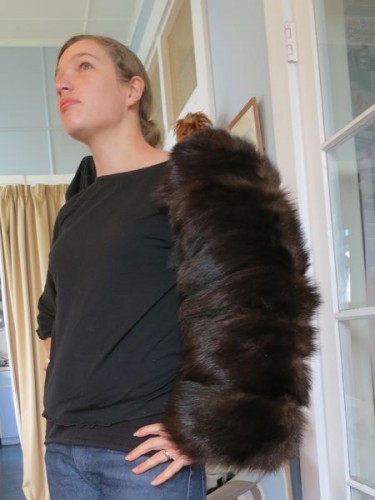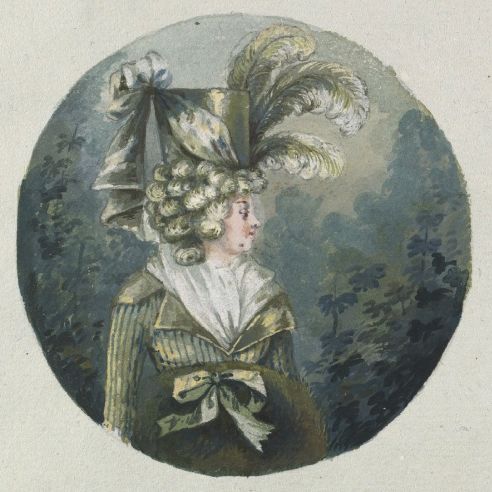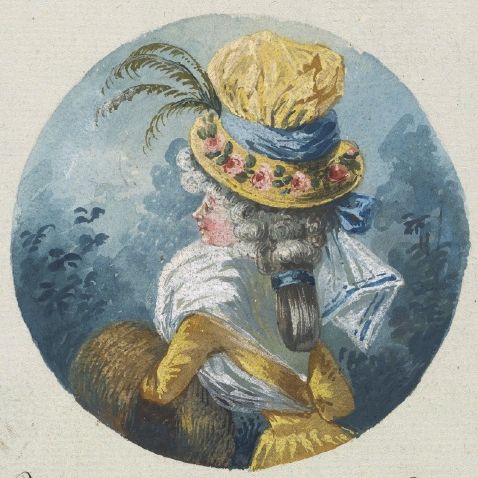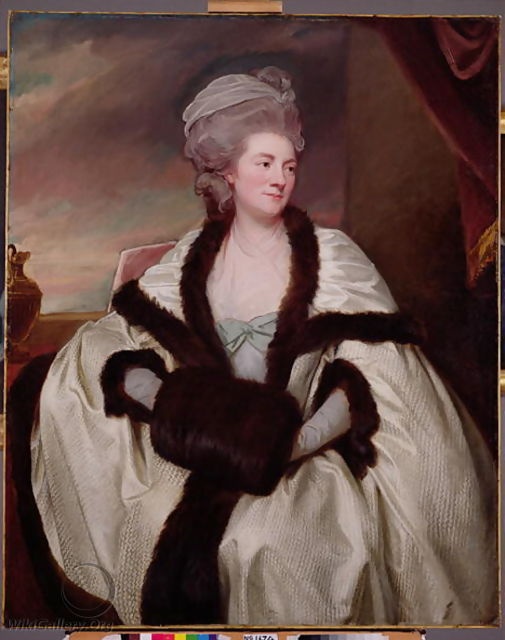As I mentioned before, I wanted to do a really complicated project for the Flora and Fauna HSF challenge, but alas, I couldn’t find the right fabric. Instead, I’m saving my energy for two big upcoming projects, and making some fun little things that will make current or future outfits fabulous.
The first of these is an 18th century fur muff. The wonderful Lynne gave me a fur sleeve which had come off of her mothers 1950s fur coat a month ago, and I noticed how wide the lower sleeve was, and how it was a perfectly even tube for the last 14cm, and thought “Ooooh…super easy fur muff.”


Famous last words…
But that was all in the future. First I needed to do a little research on 18th century fur muffs, to determine what the usual dimensions were, if my fur was plausible, and what they were lined with.
After quite a bit of research, I’ve found depictions of 18th century fur muffs ranging from the early 1760s, up to the end of the century. Unfortunately I haven’t found a single extent 18th century fur muff, so I’m going to have to base mine off what you can see in paintings, and extrapolate the rest from 18th century fabric muffs.
In looking at 18th century fur muffs I came to the conclusion that while there were extremes of fashion in muffs, there was also a standard muff size (the logical, practical muff size) in fur muffs that was used throughout the century.
Here is Madame Sophie in 1762 with a lovely dark fur muff. The texture of the fur, and the slight ridges and valleys in the fur, are very similar to my fox fur sleeve. On a woman of my size, a muff the same proportions as Madame Sophies would be between 12″-14″ long, and at least 24″ in circumference. It’s a bit hard to tell as you can’t see the bottom of the muff.

Madame Sophie de France (1734—1782) François Hubert Drouais (French, Paris 1727—1775 Paris) Date: 1762, Metropolitan Museum of Art
As the century progressed, muffs tended to get larger. Madame Mole Reymond’s fantastic 1780s brown fur muff that is definitely a bit larger than Madame Sophie’s muff:

Mme Mole Reymond by Elizabeth Vigee-Lebrun, 1787
And while this muff isn’t quite as exaggerated, it is on a slightly larger scale:

Costume Sketches, Anonymous, French, 18th century, Possibly connected to Antoine Caire-Morand (French, Brian̤on 1747 Р1825 Turin),1785-1790, MFA Boston
While larger seems to have been most fashionable, there are enough depictions of smaller muffs in the later 18th century to make me think that they were still reasonably common:

Robe de matin à l’Anglaise avec des manches en amadis jupon coupe à grand volant de mousseline fichu à double garniture Cette femme est coëffee d’un chapeau de Vegogne a long poil avec un ruban au tour, Gallerie des Modes, 1782, MFA Boston
This is good, because my sleeve isn’t big enough to make an enormous muff! And I’d love it if I could use my muff for different decades in the 18th century.
With size sorted, what to do about the lining? There are a few fashion plates that show the side of a muff, but it’s hard to determine if the dark hole they depict indicated a dark lining, or was just the idea of a hole. I rather suspect it is the latter.

Costume Sketches, Anonymous, French, 18th century, Possibly connected to Antoine Caire-Morand (French, Brian̤on 1747 Р1825 Turin),1785-1790, MFA Boston

Costume Design or Portrait Type, Anonymous, French, Possibly connected to Antoine Caire-Morand (French, Brian̤on 1747 Р1825 Turin), 1785-1790, MFA Boston
Dark holes aside, the only definitive visual evidence I could find for what a muff was lined with is Lawrence’s portrait of Elizabeth Farren carrying an elegant, oversized muff. Elizabeth’s muff looks like it is lined with a white satin that matches her fashionable hooded cloak.

Elizabeth Farren (born about 1759, died 1829), Later Countess of Derby by Sir Thomas Lawrence (British, Bristol 1769—1830 London), 1790
There are numerous portraits and fashion plates that show matching fur-trimmed cloaks and muffs, and presumably the lining of those muffs also matches the cloaks. My favourite example is Mrs Wilbraham Bootle, with her beautiful fur-trimmed cloak and small brown fur muff – so close to what I hope to achieve. I imagine her muff is lined in the same white satin that lines the hood of her cloak.

Mrs. Wilbraham Bootle, 1781 by George Romney, oil on Canvas, National Gallery of Scotland
I also quizzed the amazing Carolyn of Brocade Goddess as to what an 18th century fur muff would be lined with, and she suggested a thin silk. So, as I’m trying to sew from my stash, I settled on a scrap of white silk-cotton satin left over from Carolyn’s wedding dress.
And then, as I was struggling to figure out how to keep my wool batting from moving around too much between the silk lining and the fur outer, I had a brilliant design idea, and blithely ignored all the historical evidence.
What did I do? I’ll show you tomorrow!
In the meantime, if you want to see more 18th and other century muff goodness, check out my pinterest page.
Need more fashion history reading? The latest issue of Glory Days magazine is out, and my article on The Bifurcated Woman is on page 36.

metmuseum.orgWow. That is an enormous sleeve!
I had a lot of trouble with the muff I made for the Stripes challenge too. It’s so hard to get the dimensions right when there is a limited amount of fur. You have done much more research than I did and
I’m sure your muff will be lovely.
I have only found one extant 18th century muff that has any fuzziness to it. It’s that wacky red one from the Met that appears to be fur on the inside and feathers on the outside.
http://www.metmuseum.org/Collections/search-the-collections/80005647
Weird, but a nice, cozy option for a lining.
Isn’t it massive! The rest of the coat was shaved rabbit (to imitate sealskin) – such a wacky, fabulous 50s look.
I looked at the muff you have linked to, but I don’t think it is actually 18th century – the Met has a nearly identical one that is late 19th century, and I know of a number of other late 19th century muffs that are very similar. I suspect it is just mis-dated or mis labelled.
The Met database has a LOT of misdating and misinterpretation going on. I saw it mentioned on comments on another blog that the Met don’t allow corrections on these things if lending things out. You basically HAVE to say what their database says on your object label, even if you argue or know that it’s incorrect. I’d like to think they were more flexible than that, though…
I can sympathise with the Met to an extent – they have SO.MUCH.STUFF to go through, and research, and check, and they have to decide if it would be better to put things out, even with the wrong information (and 18th century vs. 19th century is sometimes just the slip of a finger on a keyboard), or to not put things out. I’d rather they did put things out there to see, even if some of the info is off!
Having worked in a loans department, I suspect what the other blogger wrote is a slight misunderstanding – it could be said quite accurately about the V&A (I’ve seen V&A loan agreements).
Most museums, when they lend an item, give VERY specific instructions as to what should be included on a label. After all, they made agreements with donors as to how they would be credited, etc. So after the fact I can’t imagine really *any* museum that would be OK with a borrowing institution contradicting the information they were given. There will be pages of legal documents detailing the exact labels signed off and double-initialled by both parties. During negotiations though, curators from both institutes can discuss what will go on the labels, and use the loan as an excuse to update information and research.
So if a museum wanted to borrow this muff for, say, an exhibition on the use of feathers in fashion, and had reasonable evidence that it was actually a 19th century muff, the Met would probably consider and discuss it as part of the negotiations – but once those papers are signed, what is on them is what you put up.
(and I know you know this, but I put it out there for everyone 😉 )
That’s rather disappointing, but not a big surprise.
I’ve seen items on the Met’s website that have plastic in them and are dated 1700-1930. I went and found the nearly identical one you mentioned, and it says “early 19th century”.
That’s the last time I’ll trust any of the dates on that site, it’s just too confusing for amateurs like me. Thank you for your professional opinion! I am much more willing to believe you than a museum that has more stuff than they have time to accurately document.
Most fur items meant to have a distinct shape are interlined with something to stiffen them, like…the stuff that you’d put inside the breast area of a men’s suit between the lining and the fabric. I don’t know what it’s called? I once dissected a fur stole to find two layers of such stuff between the lining and the fur, and a lot of basting going on.
Yes, shaped fur pieces have interlining, just like any shaped and supported garment. Fur is just fabric when it comes down to it. I added more to the muff when I made it. I’ll be showing detailed images tomorrow.
Haha, you’re pulling off the “I am fashionably glamorous in this single fur sleeve” look so well. It’s got me in stitches! Can’t wait to see what secrets you have to spill tomorrow.
Hey, even if its only one sleeve, with a sleeve like that you just have to be fabulous and glamorous!
I hope you like tomorrows post 😉
The sleeve almost looks like a muff on its own. No wonder you thought of one!
I love your project-research posts. It’s always good to see the options…
P.S. The link to the magazine does not work for me…
Thanks for letting me know! I’ve just checked, and apparently there was a bug, and they had to take down and re-load the magazine, so it has a new link. Hopefully this one works: http://issuu.com/glorydaysmagazine/docs/glorydaysissue2?mode=window
[…] la construction je me suis basee sur le manchon de The Dreamstress, que l’on voit ici ou là , mais comme ce manchon servira lors de sorties costumes, pour plus de pratique, j’ai […]
[WORDPRESS HASHCASH] The comment’s server IP (192.0.80.186) doesn’t match the comment’s URL host IP (76.74.254.120) and so is spam.